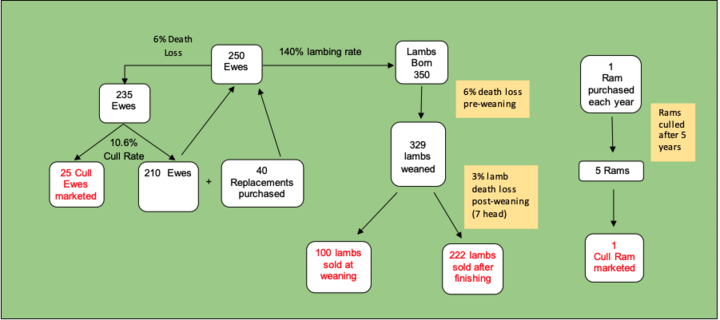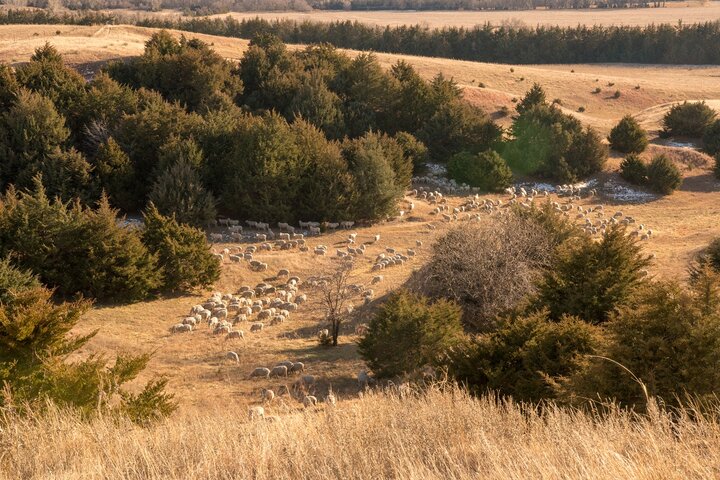Enterprise budget templates were recently updated for producers’ use to estimate sheep and goat revenue and expenses and consider projected breakeven scenarios. Using a west central Nebraska representative sheep flock with 250 ewes and a 70 head meat goat herd, the budgets are prepared for producers to use as guides when entering their own information using an Excel spreadsheet format.
The Nebraska Sheep and Goat Producers Association members and the Nebraska Meat Goat Producers provided production information for the sample budget templates. Three sheep budgets using similar size flocks reflect various practices of selling all lambs at weaning, selling part of the lamb crop at weaning, and finishing the rest or finishing all the lambs raised. In both the goat and sheep budgets, the template allows for varying how the sheep or goats are sold, either on a live weight or carcass weight basis.
Production Figures and Practices
Producers raising sheep and goats often operate diversified farms or ranches with other crop and/or livestock enterprises, however some producers have off-farm jobs and raise their sheep or goats on small farms or ranches with sheep or goats as a key enterprise. Sheep can often be added to a cattle operation, one ewe per cow, without changing the stocking rate due to the differences in forage preferences as sheep prefer forbs while cattle prefer grasses. Goats prefer browse plants and can be added at one goat per cow. If you have a lot of browse, goats may be a better enterprise than sheep. If you have more forbs, sheep might be the better choice. Goats can be used to clean areas of brush and woody plants. They will eat cedars when forced in the summer, or in the winter when nothing green is available. In some cases, producers will add sheep and goats to their cattle operation. When they add both species, they will need to adjust the stocking rate.
Both for sheep and goats, typical lambing time across much of Nebraska is in the spring. Birthing rates run around 140% (1.4 lambs per ewe), while 150% birthing rate is typical of goats, as both ewes and does often have twins or multiple births. Death loss is figured for lambs at 4.8 to 8.7% pre-weaning and for baby goats (kids) 11% death loss before they are weaned. If they are kept and fed, then post-weaning death rate of 3% was figured for the lambs and kids before being sold as finished animals.
Producers in Nebraska reported a mix of practices in either raising their own ewes as replacements or buying breeding ewes for breeding stock replacements. In the sample budgets, all replacement ewes and does are shown as purchased. The main difference in an enterprise budget designed for raising its own breeding stock is adding the feed cost in for the growth to reproductive age. A 6% death loss for the breeding ewes and a cull rate of 10.6%, require 40 replacement ewes to be purchased each year to maintain the herd at 250 ewes. In the case of the meat goat budget, a 7% death loss for the breeding does annually and a 7% cull rate for the year was used.
The flowcharts in Figures 1 and 2 provide details about the production and sale numbers used in the sample budgets.


Feed, Hay, and Pasture
With any livestock enterprise, feed costs are a major expense and should be carefully estimated. Prices for the various feed items entered in the ‘Production Parameters’ worksheet of the budget templates carry over to the ‘Variable Expense’ worksheet and the feed expense section where quantity fed amounts per animal are entered. It is important to value feed and hay raised as well as purchased feed and supplements that are used by the breeding stock, pre-weaned, and post-weaned lambs and kids being grown to finishing weight.
Both owned and rented pasture ground should also be valued. A producer who owns pasture and hay ground should consider the value being fed and utilized by the sheep or goat enterprises. If the hay or pasture weren’t used in the livestock operation, what would its production and/or rental value be if someone else paid to use it? In other words, this is the opportunity cost that should be charged as an expense toward the livestock enterprise. Individual producers may enter an opportunity cost or cash rental rate for their land use for the sheep or goat enterprises in lieu of animal unit month (AUM) values in their budgets. It is important to not duplicate the pasture expense by entering a fair market value for the AUMs in the feed area of the budget and also enter a land rental expense in the fixed cost section.
Summary Budget
The ‘Summary Budget’ worksheet summarizes total revenue and expenses from the various budget worksheets. The summary budget provides a total net revenue calculation and a net return per ewe in the case of sheep or per doe in the goat budget. In addition, breakeven price calculations for weaned lambs or kids and finished lambs or kids on a live weight and carcass weight basis are provided. The total projected sheep or goat sales by weight are figured with estimated sale prices entered in the revenue worksheet. Other worksheets in the template that feed totals to the ‘Summary Budget’ worksheet, include variable or direct expenses, fixed expenses and overhead. A real estate and property tax expense worksheet and a non-farm revenue worksheet were added based on requests made by the producers providing input into this project.
Interviews with the authors of BeefWatch newsletter articles become available throughout the month of publication and are accessible at https://go.unl.edu/podcast.
Topics covered:
Budgets & cost of production, Marketing, budgets & management

